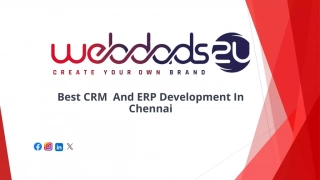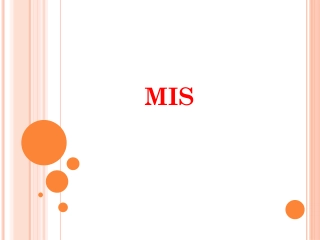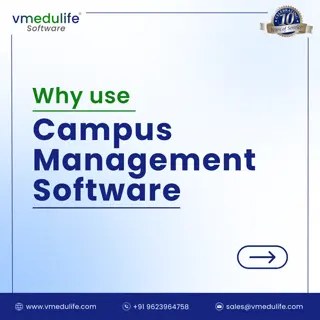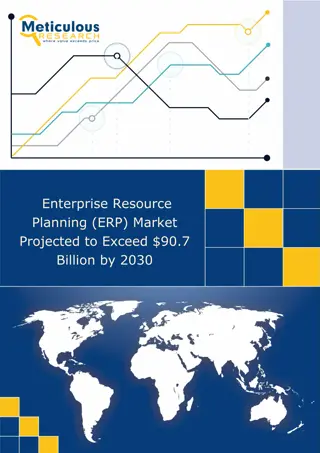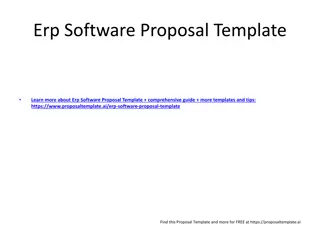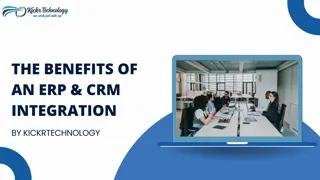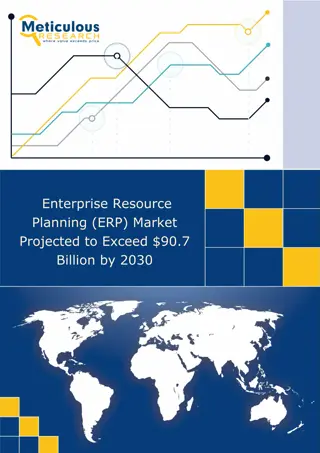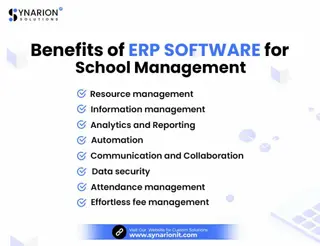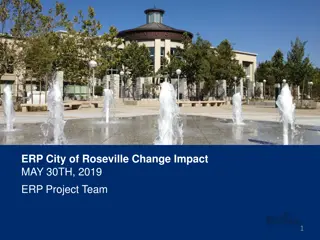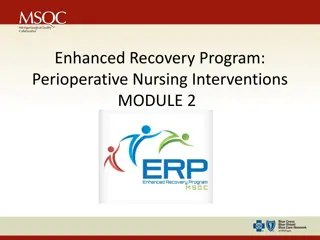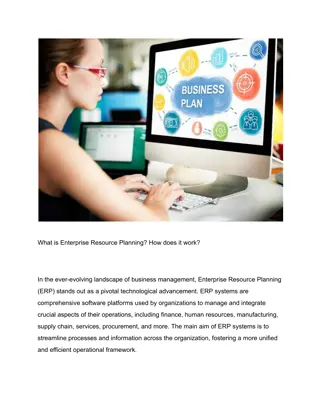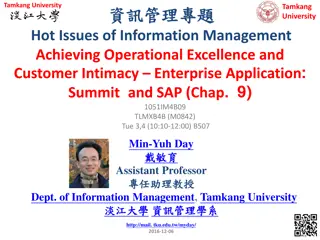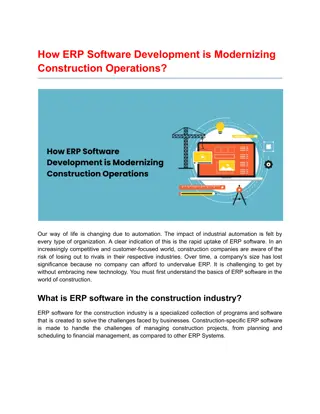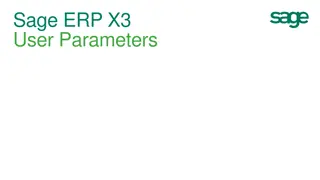Understanding Enterprise Resource Planning (ERP) Systems
Enterprise Resource Planning (ERP) systems are comprehensive business management systems designed to coordinate resources, information, and activities within an organization. From integrated systems to non-integrated ones, ERP offers various advantages such as customization, increased data security, automation of processes, and strong reporting capabilities. Discover the key features, benefits, and risks associated with ERP systems in this insightful overview.
Download Presentation

Please find below an Image/Link to download the presentation.
The content on the website is provided AS IS for your information and personal use only. It may not be sold, licensed, or shared on other websites without obtaining consent from the author. Download presentation by click this link. If you encounter any issues during the download, it is possible that the publisher has removed the file from their server.
E N D
Presentation Transcript
ERP Dr. Wurood albayati
ERP Enterprise resource Planning It is an overall business management system that caters need of all the people connected with the organization. Every organization uses variety of resources in achieving its organization goals. It designed to coordinate all the resources, information, and activities needed to complete business processes. Accounting and Finance function is considered as backbone for any business, hence Financial & Accounting Systems are an important and integral part of ERP systems. An ERP system supports most of the business system such as Manufacturing, Supply Chain Management, Financials, Projects, Human Resources and Customer Relationship Management.
ERP Design An ERP system is based on a common database and a modular software design. The common database allows storing and retrieving information in real-time. The modular software design means a business can select the modules they need, mix and match modules, and add new modules of their own to improve business performance. In practice the ERP system may comprise a set of applications, each maintaining a data store within one physical database. An ideal ERP system is that system where a single database is utilized and contains all data for various software modules
A Non-Integrated System is a system of maintaining data in a decentralized way. Each department shall maintain its own data separately and not in an integrated way. This is the major problem with non-integrated systems. The problems that could occurs in non integrated system are: a. Communication Gaps b. Mismatched Data Communication between different business units is a major aspect for success of any organization.
Advantages of an ERP System Ability to customize an organization's requirements; Integrate business: e.g. itegerate operations with accounting and financial reporting functions; Increased data security and application controls; Build strong access and isolation of duties controls; Automate many manual processes thus eliminating errors; Process huge volumes of data within short time frames; and Strong reporting capabilities which aids management and other stakeholders in appropriate decision making.
What is the risk of ERP In Non-Integrated System, data is stored by each department separately, hence this is risk is low in such an environment Major feature of an ERP System is central database. As the complete data is stored centrally at one place, ensuring safety of data and minimizing risk of loss of data is a big challenge. In an ERP environment, all the persons in the organization access the same set of data on a day to basis. This again poses the risk of leakage of information or access of information to non-related people ( unauthorized) . E.g. A person from sales department checking salary of a person in production. Again, as there is central database, all users shall use the same data for recording of transactions. Hence there is one more risk of putting incorrect data in the system by unrelated users. E.g. a person in human resource department recording a purchase order. Physical safety of data : Risk of total loss of data and Risk of partial loss of data
CASE STUDY #1- A CHARTERED ACCOUNTANT FIRM The working environment in CA(a Chartered Accountant ) firm ( service company) let us consider possibility of implementing ERP system in a CA Firm. Case 1 ) Ahmed a client of a service company provider ( CA Firm)) receives a notice for inspection assessment from Income Tax Department. Following shall be the events in normal case. Ahmed (Client ) informs about receipt of notice to CA. the partner (Baqer) on phone and sends the copy of notice to CA Firm. Notice is received at CA firm, read and understood. A task for giving reply to Income Tax Department is assigned to an employee1 ( Nada an article clerk). Emplyee1 (Nada )asks for some original documents (PAN, Memorandum of Articls, Agreements etc.) from client for working. These documents need to returned to client after the work. Nada works on this task, prepare the reply and submits it with Income Tax Department. Also she updates CA. Baqer and the accountant about it.
Bill is prepared by the accountant and approved by CA. Baqer. Bill is submitted with client. Documents are returned to client. Cheque received from client against the bill submitted. Receipt is recorded in books of accounts. This is how a simple case is handled in a CA Firm. Let us now discuss important points regarding this case. In case of any ERP System, two aspects are very important. Communication (Internal and External) Documentation
Work Flow using Integrated System Communication in this case is starting from client Suggest a good ERP solution to this scenario
In this whole process, two important aspects, i.e. Communication and Documentation are taken care of in the best possible manner. Instead of a person communicating with other, system is communicating automatically after every updating.
Things to remembered In case of Integrated System, there shall be only one system of communication with others But in case of non-integrated system people use multiple modes for communication like making a phone call, sending SMS, Email, WhatsApp or personal meeting. The major problem with these multiple option is that there is no inter- connectivity between these modes and hence track of the overall process is not available.
ERP case study #2: Hershey Candies failure Not every ERP ends in success, this case study reviews the failure of Hershey, a 147 year-old confectioner, headquartered in Hershey Pennsylvania. The enterprise saw the implementation of an ERP platform as being central to its future growth. Consequently, rather than approaching its business challenge on the basis of an iterative approach ( or continuous improving) , it decided to execute a holistic plan, involving every operating centre in the company ( redesign /reengineering). Subsequently SAP was engaged to implement a $10 million systems
The impact of this decision represented complete chaos, where the company was unable to conduct business, because virtually every process, policy, and operating mechanism was in flux simultaneously. The consequent result was the loss of $150 million in revenue, a 19% reduction in share price, and the loss of 12% in international market share.
ERP case study #3: - success Nestle SA As a enormous international candy-maker, Nestle SA headquartered in Konicki Switzerland, had harboured a goal of integrating ERP across all three of its operating companies; Nestle SA, Nestle UK, and Nestle USA. The latter operation had been working toward complete integration of a set of ERP solutions since in the late 90s, but various requirements, organizational, and policy problems had plagued the complete initiation.
By the turn of the millennium, its management finally decided that a complete re-approach to its business requirements were in order. Consequently, this effort paid dividends that allowed SAP to finally get the $200 million job done. Ultimately, positive business impacts included : the merging of an outdated accounting structure, better and more efficient communications throughout its supply-chain, and a much more confident workforce.


